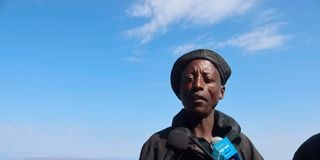Traditions that have saved Mt Kulal — a gem in the desert

Mt Kulal Community Forest Association member Andrew Leyamyam during the interview He expressed hope that their conservation initiatives would be passed to future generations to ensure the posterity of Mt Kulal Forest.
What you need to know:
- Mt Kulal is the only biosphere in northern Kenya. It has been a UNESCO Man and Biosphere (MAB) Reserve since 1979 and covers 622 sq km.
- It captures moisture, providing hydrological services for the entire northern Kenya region. There are 701 MAB reserves in 124 countries globally.
In the rugged terrain of Marsabit County is a community that has earned admiration for its exceptional resource stewardship and conservation efforts. Under Joseph Lenges's guidance, the community has been incorporating traditional ecological knowledge systems in their conservation initiatives, which has proved effective in preserving the rich biological diversity of Mt Kulal Forest.
For over half a century, the Community Forest Association (CFA) in Mt Kulal under the leadership of Mr Lenges, has been instrumental in implementing conservation initiatives, which have contributed to the survival of the forest. The forest has endangered wildlife and plant species, , including medicinal herbs. Thanks to the community's efforts, the forest remains intact, providing a safe haven for these species and helping preserve the ecosystem's delicate balance.
"For decades now, the conservation of Mt Kulal Forest has been the sole responsibility of the local community, and this should be a case study on how best locals can participate in environmental conservation and biodiversity," Mr Lenges said.
Through the CFA, they formed an environmental conservation watchdog known as 'Wazee wa mazingira’ to ensure that the indigenous forest is protected.
He noted that their efforts align with the Global Biodiversity Framework's (GBF) target, which aims to protect 30 per cent of the planet by 2030. This initiative focuses on community-centred conservation approaches to halt and reverse nature loss. The GBF was adopted during the 15th Conference of Parties to the UN Convention on Biological Diversity. He also hailed the Samburu and Rendille communities’traditional beliefs and taboos, which require people to obey their religious and cultural regulations. Here, residents treat nature and environmental conservation as a God-given duty, with elders and opinion leaders at the forefront of conservation.
Mt Kulal is the only biosphere in northern Kenya. It has been a UNESCO Man and Biosphere (MAB) Reserve since 1979 and covers 622 sq km. It captures moisture, providing hydrological services for the entire northern Kenya region. There are 701 MAB reserves in 124 countries globally.
Mt Kulal is considered a sacred forest and elders hold different cultural events there such as age-set rituals, where sheep are usually slaughtered under fig trees that are considered shrines. So sacred is this forest to the community that those found logging are cursed or fined.
Mr Lenges talks of a time in August 2023 when three young men cut trees in the forest and were forced to pay a fine of Sh20,000 each or face elders’ curses.
The Mt Kulal CFA has been working collaboratively with the county government, the Food and Agriculture Organization and other UN agencies to promote natural resource conservation in the region.
The mountain is home to the unique Heuglin's white-eye bird species, also known as the Kulal White-eye Zosterops kulalensis, as well as the stump-nosed chameleon species known as Trioceros Narraioca.
According to FAO, Mt Kulal is also considered a vital cradle of the sweet-smelling frankincense and myrrh family, which is in high demand in the United Arab Emirates.
In August 2021, FAO declared its interest in addressing the environmental degradation challenges faced by the region. The Global Environment Facility project focused on restoring Kenya's arid and semi-arid lands through bio-enterprise development.
The project focuses on two forest landscapes — Mukogondo Forest in Laikipia County and Mt Kulal Forest.
In Ngare Ndare Forest in Meru, six communities have partnered with rangers to conserve the forest, which is rich in diversity of indigenous tree species and wildlife, some of which are critically endangered.
Ngare Ndare Forest is a delectable indigenous forest on the northern slopes of Mt Kenya. The forest is home to some rare indigenous tree species dating back over 200 years, and its canopy supports a rich variety of birds and wildlife. It is also a significant wildlife corridor that connects the Lewa Conservancy and Northern Kenya to the Mt Kenya Forest reserve, which is crucial for elephant movements.
Six local communities living in the forest's border areas formed the Ngare Ndare Forest Trust to ensure sustained environmental and nature conservation.
Previously, the forest witnessed wanton logging of cedar trees, especially between the 1980s and 1990s.
In 2017 alone, at least 173 red cedar trees were cut down in the Mt Kenya ecosystem such as the Kabaru and Gathiuru areas.
The Kaburu area alone saw at least 433 hectares of red cedar laid bare as the trees were at the mercy of termites.
Among the stringent measures that have contained the logging of red cedar was the enforcement of a law that made anyone culpable of logging fined up to Sh200,000 and sentenced to two years.





